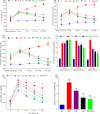Hesperidin improves insulin resistance via down-regulation of inflammatory responses: Biochemical analysis and in silico validation
- PMID: 31929574
- PMCID: PMC6957178
- DOI: 10.1371/journal.pone.0227637
Hesperidin improves insulin resistance via down-regulation of inflammatory responses: Biochemical analysis and in silico validation
Erratum in
-
Correction: Hesperidin improves insulin resistance via down-regulation of inflammatory responses: Biochemical analysis and in silico validation.PLoS One. 2020 Feb 12;15(2):e0229348. doi: 10.1371/journal.pone.0229348. eCollection 2020. PLoS One. 2020. PMID: 32049981 Free PMC article.
Abstract
Leptin resistance and co-existing insulin resistance is considered as hallmark of diet-induced obesity. Here, we investigated therapeutic potential of hesperidin to improve leptin and insulin resistance using high fat diet (HFD)-induced obese experimental animal model. We also performed in silico studies to validate therapeutic effectiveness of hesperidin by performing protein-ligand docking and molecular dynamics simulation studies. Group 1 was identified as control group receiving vehicle only. Group 2 was marked as non-treated group receiving 60% HFD. While, other groups were treated daily with orlistat (120 mg/kg/d), hesperidin (55 mg/kg/d), combination of hesperidin (55 mg/kg/d) + orlistat (120 mg/kg/d). Hesperidin alone (P<0.001) and particularly in combination with orlistat (P<0.001), resulted in controlling the levels of HFD-altered biomarkers including random and fasting state of glycemia, leptin and insulin resistance. Similarly, hesperidin also improved the serum and tissue levels of leptin, interleukin-6 and tumor necrosis factor-alpha more significantly (P<0.05) when compared with that of orlistat. These results were found to be in accordance with the results of histopathological examination of pancreas, liver and adipose tissues. In-silico studies also proved that hesperidin binds to leptin receptor with higher affinity as compared to that of orlistat and induces the favorable variations in geometrical conformation of leptin receptor to promote its association with leptin which may lead to the cascades of reactions culminating the lipolysis of fats that may ultimately lead to cure obesity. The results of this study may be a significant expectation among the forthcoming treatment strategies for leptin and insulin resistance.
Conflict of interest statement
The authors have declared that no competing interests exist.
Figures









References
Publication types
MeSH terms
Substances
LinkOut - more resources
Full Text Sources
Medical

